Global Financial Crisis (2008): Keynesian and Financialization Views
VerifiedAdded on 2021/04/19
|13
|3711
|21
Essay
AI Summary
This essay provides a comparative analysis of the Global Financial Crisis (GFC) of 2008 from the perspectives of Keynesian economics and financialization theory. It begins by outlining the Keynesian view, emphasizing the role of insufficient aggregate demand, income inequality, and government monetary policies in exacerbating the crisis. The essay then explores the financialization perspective, highlighting the distortions in financial agreements, the disconnect between financial and real wealth, and the impact of neoliberal policies. The analysis includes discussions of subprime mortgages, the role of hot money, and the rise of financial debt. The essay compares and contrasts the causes and consequences of the GFC as explained by these two theoretical models, offering a comprehensive understanding of the economic factors that contributed to the crisis and their respective interpretations. The essay concludes by summarizing the findings and illustrating how different theories explain the GFC effectively over time.
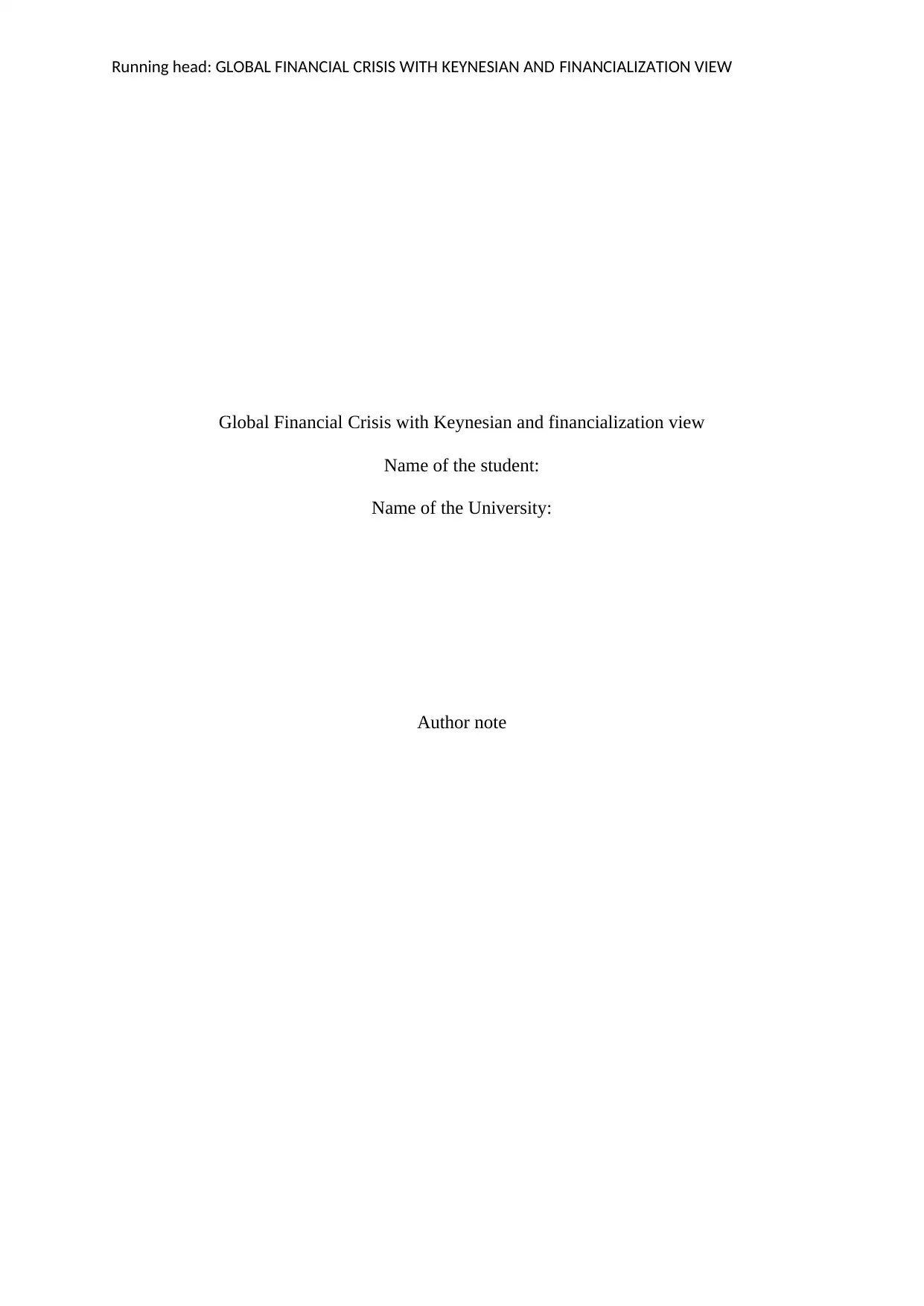
Running head: GLOBAL FINANCIAL CRISIS WITH KEYNESIAN AND FINANCIALIZATION VIEW
Global Financial Crisis with Keynesian and financialization view
Name of the student:
Name of the University:
Author note
Global Financial Crisis with Keynesian and financialization view
Name of the student:
Name of the University:
Author note
Paraphrase This Document
Need a fresh take? Get an instant paraphrase of this document with our AI Paraphraser
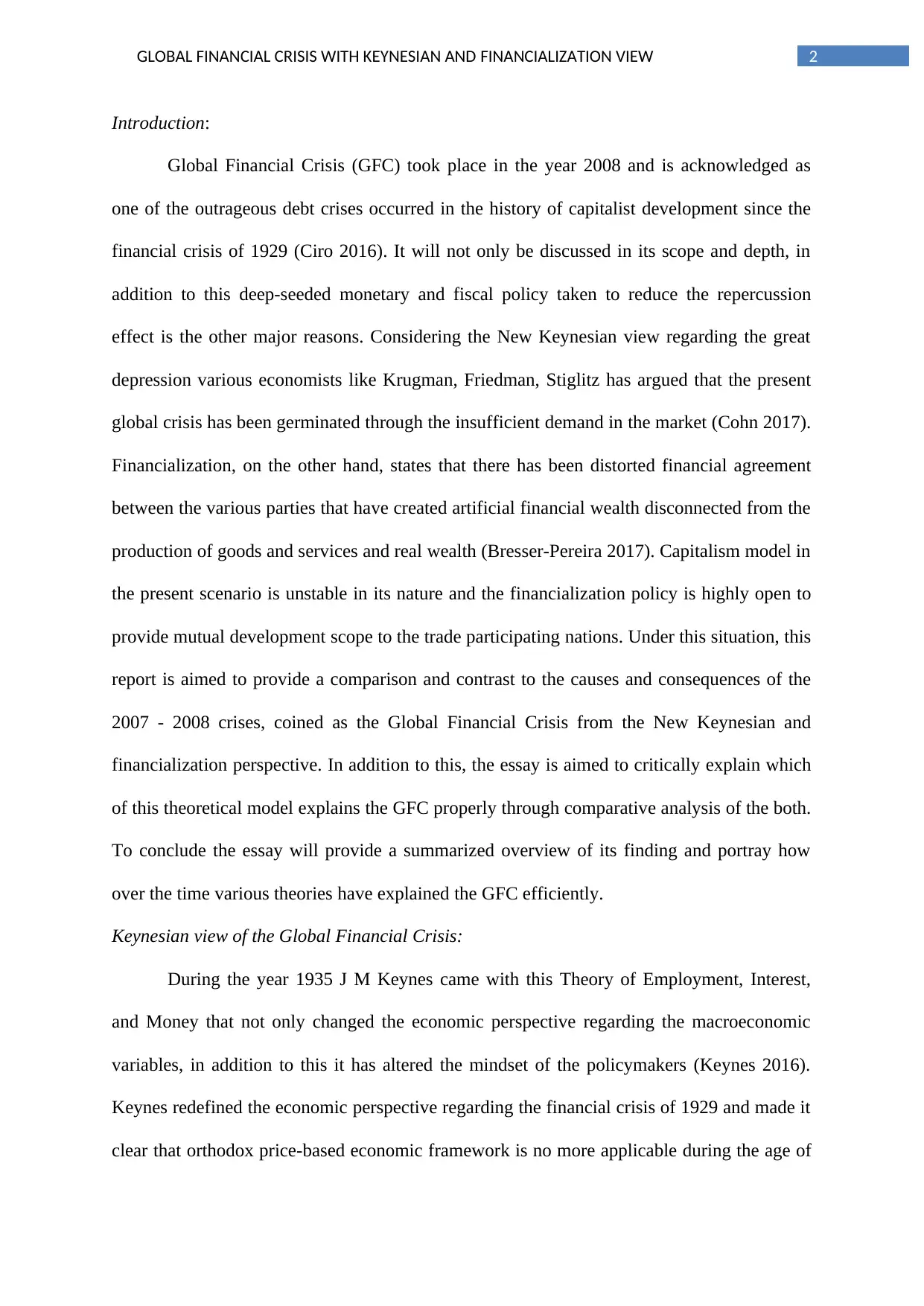
2GLOBAL FINANCIAL CRISIS WITH KEYNESIAN AND FINANCIALIZATION VIEW
Introduction:
Global Financial Crisis (GFC) took place in the year 2008 and is acknowledged as
one of the outrageous debt crises occurred in the history of capitalist development since the
financial crisis of 1929 (Ciro 2016). It will not only be discussed in its scope and depth, in
addition to this deep-seeded monetary and fiscal policy taken to reduce the repercussion
effect is the other major reasons. Considering the New Keynesian view regarding the great
depression various economists like Krugman, Friedman, Stiglitz has argued that the present
global crisis has been germinated through the insufficient demand in the market (Cohn 2017).
Financialization, on the other hand, states that there has been distorted financial agreement
between the various parties that have created artificial financial wealth disconnected from the
production of goods and services and real wealth (Bresser-Pereira 2017). Capitalism model in
the present scenario is unstable in its nature and the financialization policy is highly open to
provide mutual development scope to the trade participating nations. Under this situation, this
report is aimed to provide a comparison and contrast to the causes and consequences of the
2007 - 2008 crises, coined as the Global Financial Crisis from the New Keynesian and
financialization perspective. In addition to this, the essay is aimed to critically explain which
of this theoretical model explains the GFC properly through comparative analysis of the both.
To conclude the essay will provide a summarized overview of its finding and portray how
over the time various theories have explained the GFC efficiently.
Keynesian view of the Global Financial Crisis:
During the year 1935 J M Keynes came with this Theory of Employment, Interest,
and Money that not only changed the economic perspective regarding the macroeconomic
variables, in addition to this it has altered the mindset of the policymakers (Keynes 2016).
Keynes redefined the economic perspective regarding the financial crisis of 1929 and made it
clear that orthodox price-based economic framework is no more applicable during the age of
Introduction:
Global Financial Crisis (GFC) took place in the year 2008 and is acknowledged as
one of the outrageous debt crises occurred in the history of capitalist development since the
financial crisis of 1929 (Ciro 2016). It will not only be discussed in its scope and depth, in
addition to this deep-seeded monetary and fiscal policy taken to reduce the repercussion
effect is the other major reasons. Considering the New Keynesian view regarding the great
depression various economists like Krugman, Friedman, Stiglitz has argued that the present
global crisis has been germinated through the insufficient demand in the market (Cohn 2017).
Financialization, on the other hand, states that there has been distorted financial agreement
between the various parties that have created artificial financial wealth disconnected from the
production of goods and services and real wealth (Bresser-Pereira 2017). Capitalism model in
the present scenario is unstable in its nature and the financialization policy is highly open to
provide mutual development scope to the trade participating nations. Under this situation, this
report is aimed to provide a comparison and contrast to the causes and consequences of the
2007 - 2008 crises, coined as the Global Financial Crisis from the New Keynesian and
financialization perspective. In addition to this, the essay is aimed to critically explain which
of this theoretical model explains the GFC properly through comparative analysis of the both.
To conclude the essay will provide a summarized overview of its finding and portray how
over the time various theories have explained the GFC efficiently.
Keynesian view of the Global Financial Crisis:
During the year 1935 J M Keynes came with this Theory of Employment, Interest,
and Money that not only changed the economic perspective regarding the macroeconomic
variables, in addition to this it has altered the mindset of the policymakers (Keynes 2016).
Keynes redefined the economic perspective regarding the financial crisis of 1929 and made it
clear that orthodox price-based economic framework is no more applicable during the age of
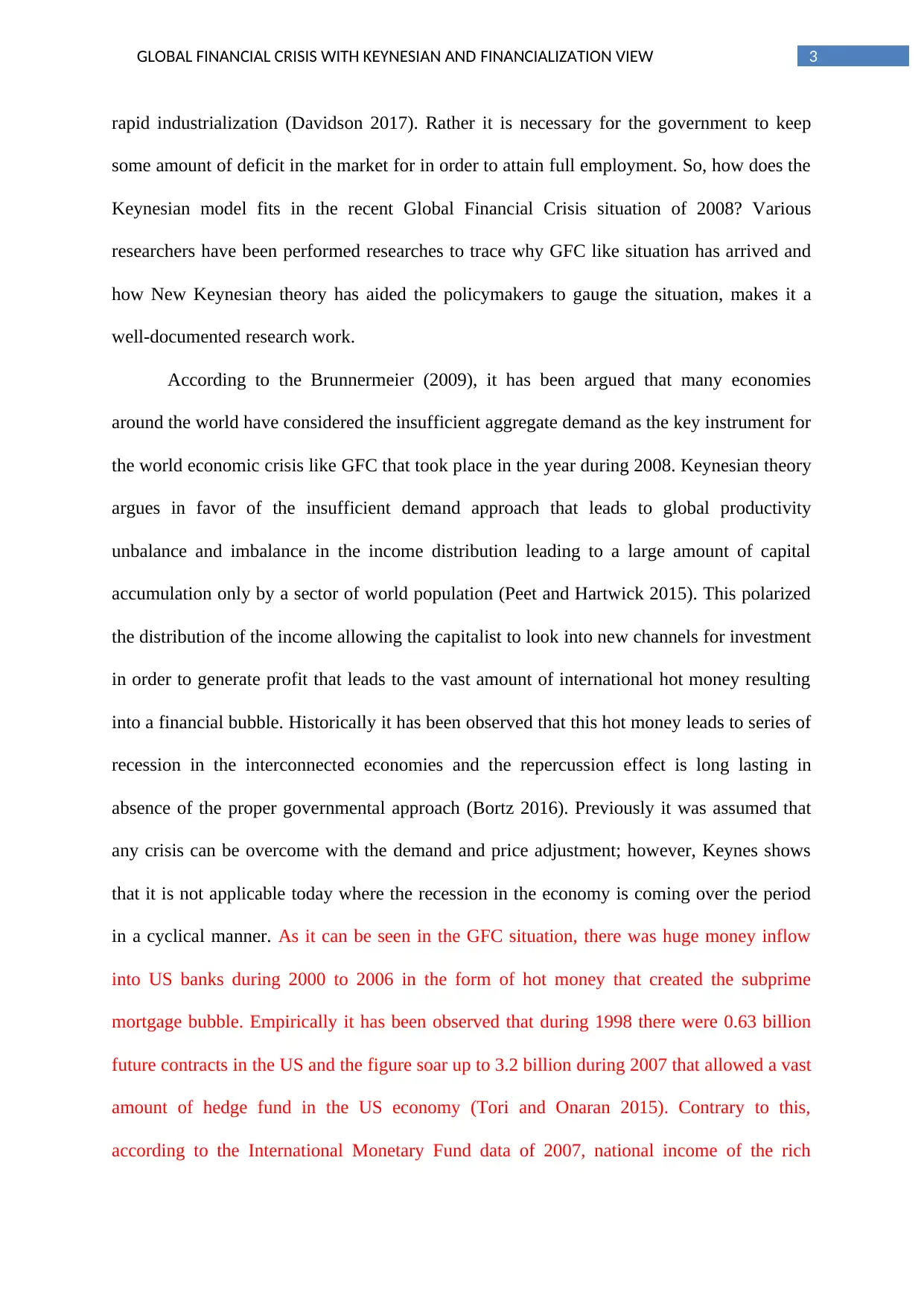
3GLOBAL FINANCIAL CRISIS WITH KEYNESIAN AND FINANCIALIZATION VIEW
rapid industrialization (Davidson 2017). Rather it is necessary for the government to keep
some amount of deficit in the market for in order to attain full employment. So, how does the
Keynesian model fits in the recent Global Financial Crisis situation of 2008? Various
researchers have been performed researches to trace why GFC like situation has arrived and
how New Keynesian theory has aided the policymakers to gauge the situation, makes it a
well-documented research work.
According to the Brunnermeier (2009), it has been argued that many economies
around the world have considered the insufficient aggregate demand as the key instrument for
the world economic crisis like GFC that took place in the year during 2008. Keynesian theory
argues in favor of the insufficient demand approach that leads to global productivity
unbalance and imbalance in the income distribution leading to a large amount of capital
accumulation only by a sector of world population (Peet and Hartwick 2015). This polarized
the distribution of the income allowing the capitalist to look into new channels for investment
in order to generate profit that leads to the vast amount of international hot money resulting
into a financial bubble. Historically it has been observed that this hot money leads to series of
recession in the interconnected economies and the repercussion effect is long lasting in
absence of the proper governmental approach (Bortz 2016). Previously it was assumed that
any crisis can be overcome with the demand and price adjustment; however, Keynes shows
that it is not applicable today where the recession in the economy is coming over the period
in a cyclical manner. As it can be seen in the GFC situation, there was huge money inflow
into US banks during 2000 to 2006 in the form of hot money that created the subprime
mortgage bubble. Empirically it has been observed that during 1998 there were 0.63 billion
future contracts in the US and the figure soar up to 3.2 billion during 2007 that allowed a vast
amount of hedge fund in the US economy (Tori and Onaran 2015). Contrary to this,
according to the International Monetary Fund data of 2007, national income of the rich
rapid industrialization (Davidson 2017). Rather it is necessary for the government to keep
some amount of deficit in the market for in order to attain full employment. So, how does the
Keynesian model fits in the recent Global Financial Crisis situation of 2008? Various
researchers have been performed researches to trace why GFC like situation has arrived and
how New Keynesian theory has aided the policymakers to gauge the situation, makes it a
well-documented research work.
According to the Brunnermeier (2009), it has been argued that many economies
around the world have considered the insufficient aggregate demand as the key instrument for
the world economic crisis like GFC that took place in the year during 2008. Keynesian theory
argues in favor of the insufficient demand approach that leads to global productivity
unbalance and imbalance in the income distribution leading to a large amount of capital
accumulation only by a sector of world population (Peet and Hartwick 2015). This polarized
the distribution of the income allowing the capitalist to look into new channels for investment
in order to generate profit that leads to the vast amount of international hot money resulting
into a financial bubble. Historically it has been observed that this hot money leads to series of
recession in the interconnected economies and the repercussion effect is long lasting in
absence of the proper governmental approach (Bortz 2016). Previously it was assumed that
any crisis can be overcome with the demand and price adjustment; however, Keynes shows
that it is not applicable today where the recession in the economy is coming over the period
in a cyclical manner. As it can be seen in the GFC situation, there was huge money inflow
into US banks during 2000 to 2006 in the form of hot money that created the subprime
mortgage bubble. Empirically it has been observed that during 1998 there were 0.63 billion
future contracts in the US and the figure soar up to 3.2 billion during 2007 that allowed a vast
amount of hedge fund in the US economy (Tori and Onaran 2015). Contrary to this,
according to the International Monetary Fund data of 2007, national income of the rich
⊘ This is a preview!⊘
Do you want full access?
Subscribe today to unlock all pages.

Trusted by 1+ million students worldwide
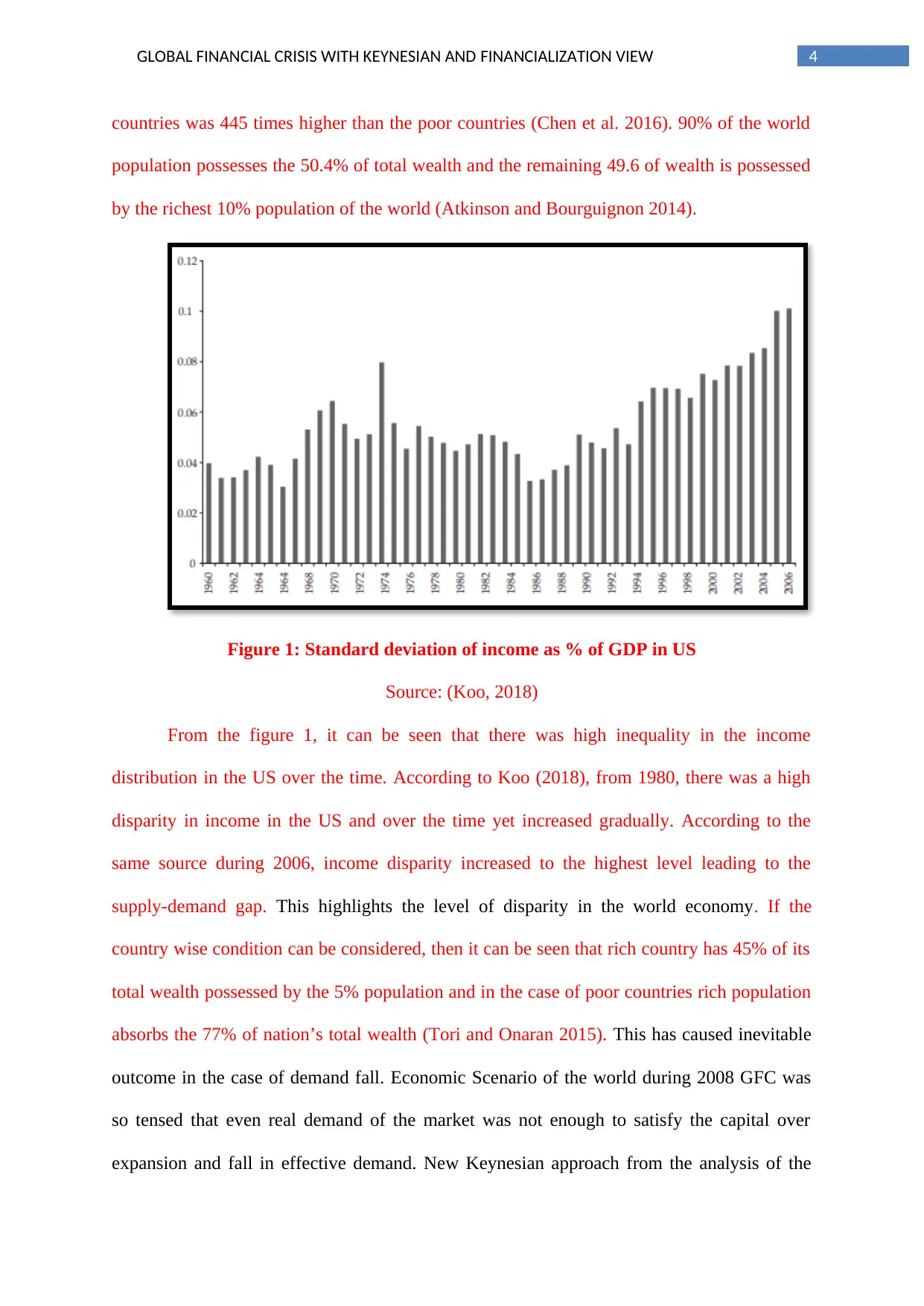
4GLOBAL FINANCIAL CRISIS WITH KEYNESIAN AND FINANCIALIZATION VIEW
countries was 445 times higher than the poor countries (Chen et al. 2016). 90% of the world
population possesses the 50.4% of total wealth and the remaining 49.6 of wealth is possessed
by the richest 10% population of the world (Atkinson and Bourguignon 2014).
Figure 1: Standard deviation of income as % of GDP in US
Source: (Koo, 2018)
From the figure 1, it can be seen that there was high inequality in the income
distribution in the US over the time. According to Koo (2018), from 1980, there was a high
disparity in income in the US and over the time yet increased gradually. According to the
same source during 2006, income disparity increased to the highest level leading to the
supply-demand gap. This highlights the level of disparity in the world economy. If the
country wise condition can be considered, then it can be seen that rich country has 45% of its
total wealth possessed by the 5% population and in the case of poor countries rich population
absorbs the 77% of nation’s total wealth (Tori and Onaran 2015). This has caused inevitable
outcome in the case of demand fall. Economic Scenario of the world during 2008 GFC was
so tensed that even real demand of the market was not enough to satisfy the capital over
expansion and fall in effective demand. New Keynesian approach from the analysis of the
countries was 445 times higher than the poor countries (Chen et al. 2016). 90% of the world
population possesses the 50.4% of total wealth and the remaining 49.6 of wealth is possessed
by the richest 10% population of the world (Atkinson and Bourguignon 2014).
Figure 1: Standard deviation of income as % of GDP in US
Source: (Koo, 2018)
From the figure 1, it can be seen that there was high inequality in the income
distribution in the US over the time. According to Koo (2018), from 1980, there was a high
disparity in income in the US and over the time yet increased gradually. According to the
same source during 2006, income disparity increased to the highest level leading to the
supply-demand gap. This highlights the level of disparity in the world economy. If the
country wise condition can be considered, then it can be seen that rich country has 45% of its
total wealth possessed by the 5% population and in the case of poor countries rich population
absorbs the 77% of nation’s total wealth (Tori and Onaran 2015). This has caused inevitable
outcome in the case of demand fall. Economic Scenario of the world during 2008 GFC was
so tensed that even real demand of the market was not enough to satisfy the capital over
expansion and fall in effective demand. New Keynesian approach from the analysis of the
Paraphrase This Document
Need a fresh take? Get an instant paraphrase of this document with our AI Paraphraser
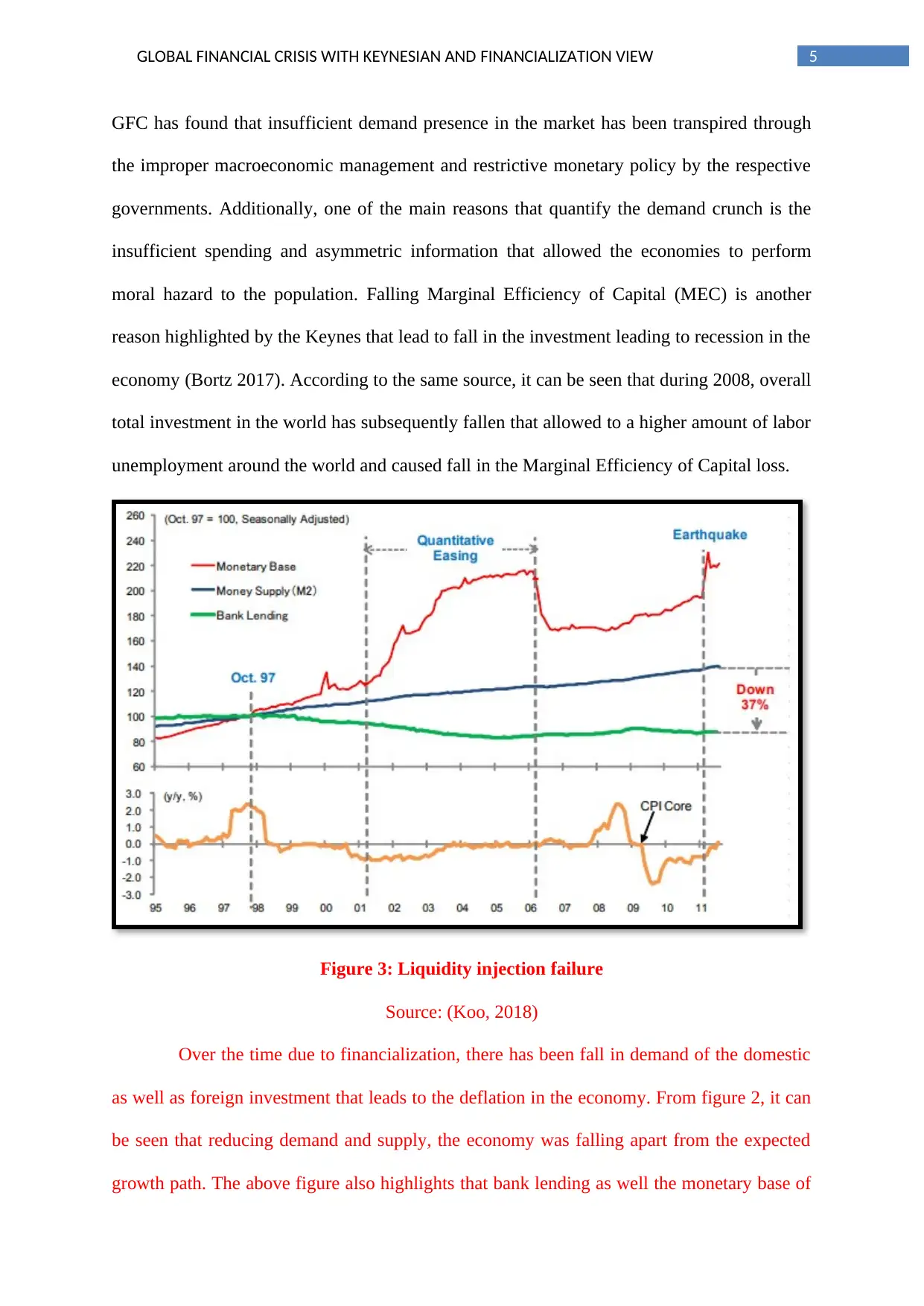
5GLOBAL FINANCIAL CRISIS WITH KEYNESIAN AND FINANCIALIZATION VIEW
GFC has found that insufficient demand presence in the market has been transpired through
the improper macroeconomic management and restrictive monetary policy by the respective
governments. Additionally, one of the main reasons that quantify the demand crunch is the
insufficient spending and asymmetric information that allowed the economies to perform
moral hazard to the population. Falling Marginal Efficiency of Capital (MEC) is another
reason highlighted by the Keynes that lead to fall in the investment leading to recession in the
economy (Bortz 2017). According to the same source, it can be seen that during 2008, overall
total investment in the world has subsequently fallen that allowed to a higher amount of labor
unemployment around the world and caused fall in the Marginal Efficiency of Capital loss.
Figure 3: Liquidity injection failure
Source: (Koo, 2018)
Over the time due to financialization, there has been fall in demand of the domestic
as well as foreign investment that leads to the deflation in the economy. From figure 2, it can
be seen that reducing demand and supply, the economy was falling apart from the expected
growth path. The above figure also highlights that bank lending as well the monetary base of
GFC has found that insufficient demand presence in the market has been transpired through
the improper macroeconomic management and restrictive monetary policy by the respective
governments. Additionally, one of the main reasons that quantify the demand crunch is the
insufficient spending and asymmetric information that allowed the economies to perform
moral hazard to the population. Falling Marginal Efficiency of Capital (MEC) is another
reason highlighted by the Keynes that lead to fall in the investment leading to recession in the
economy (Bortz 2017). According to the same source, it can be seen that during 2008, overall
total investment in the world has subsequently fallen that allowed to a higher amount of labor
unemployment around the world and caused fall in the Marginal Efficiency of Capital loss.
Figure 3: Liquidity injection failure
Source: (Koo, 2018)
Over the time due to financialization, there has been fall in demand of the domestic
as well as foreign investment that leads to the deflation in the economy. From figure 2, it can
be seen that reducing demand and supply, the economy was falling apart from the expected
growth path. The above figure also highlights that bank lending as well the monetary base of
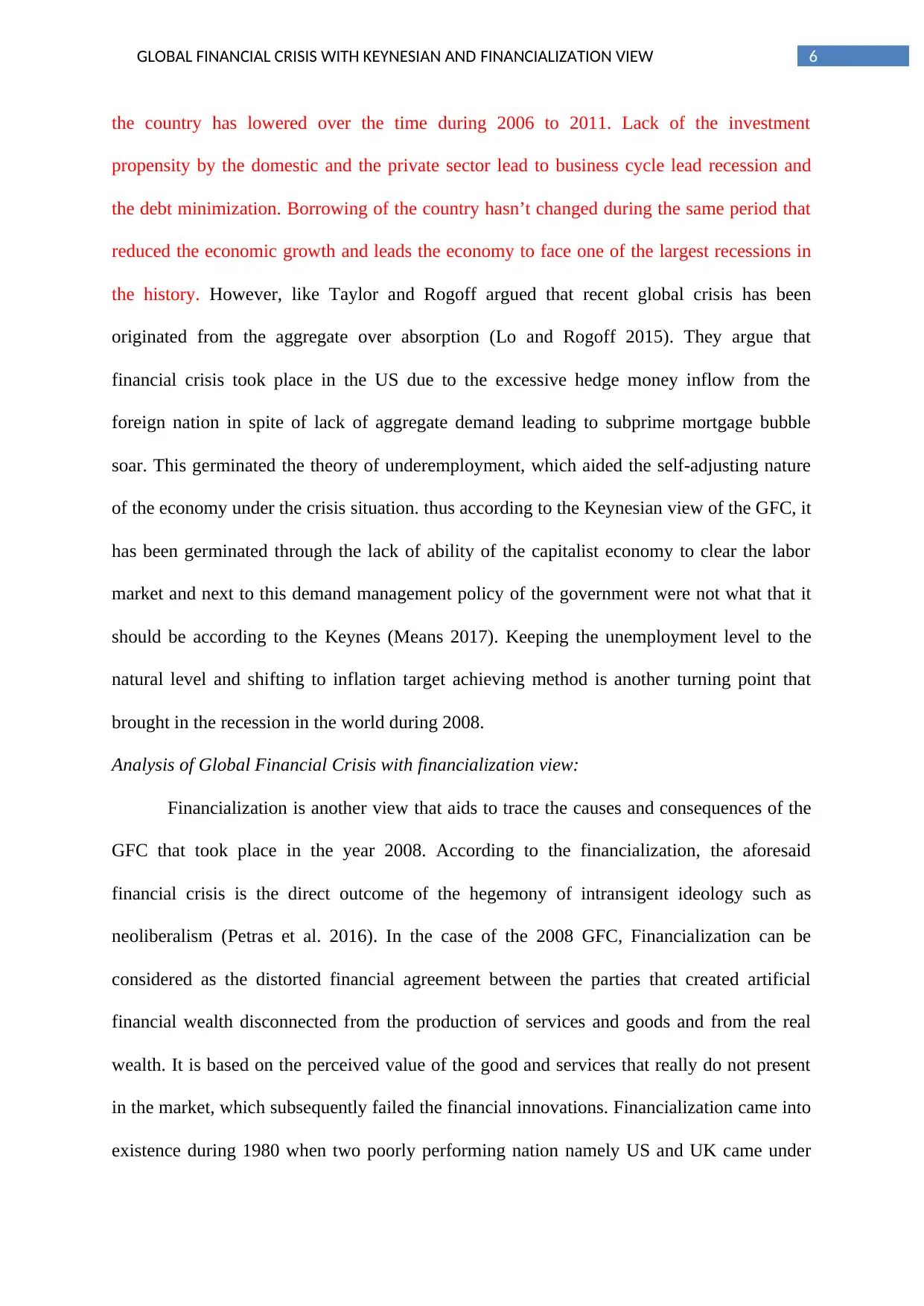
6GLOBAL FINANCIAL CRISIS WITH KEYNESIAN AND FINANCIALIZATION VIEW
the country has lowered over the time during 2006 to 2011. Lack of the investment
propensity by the domestic and the private sector lead to business cycle lead recession and
the debt minimization. Borrowing of the country hasn’t changed during the same period that
reduced the economic growth and leads the economy to face one of the largest recessions in
the history. However, like Taylor and Rogoff argued that recent global crisis has been
originated from the aggregate over absorption (Lo and Rogoff 2015). They argue that
financial crisis took place in the US due to the excessive hedge money inflow from the
foreign nation in spite of lack of aggregate demand leading to subprime mortgage bubble
soar. This germinated the theory of underemployment, which aided the self-adjusting nature
of the economy under the crisis situation. thus according to the Keynesian view of the GFC, it
has been germinated through the lack of ability of the capitalist economy to clear the labor
market and next to this demand management policy of the government were not what that it
should be according to the Keynes (Means 2017). Keeping the unemployment level to the
natural level and shifting to inflation target achieving method is another turning point that
brought in the recession in the world during 2008.
Analysis of Global Financial Crisis with financialization view:
Financialization is another view that aids to trace the causes and consequences of the
GFC that took place in the year 2008. According to the financialization, the aforesaid
financial crisis is the direct outcome of the hegemony of intransigent ideology such as
neoliberalism (Petras et al. 2016). In the case of the 2008 GFC, Financialization can be
considered as the distorted financial agreement between the parties that created artificial
financial wealth disconnected from the production of services and goods and from the real
wealth. It is based on the perceived value of the good and services that really do not present
in the market, which subsequently failed the financial innovations. Financialization came into
existence during 1980 when two poorly performing nation namely US and UK came under
the country has lowered over the time during 2006 to 2011. Lack of the investment
propensity by the domestic and the private sector lead to business cycle lead recession and
the debt minimization. Borrowing of the country hasn’t changed during the same period that
reduced the economic growth and leads the economy to face one of the largest recessions in
the history. However, like Taylor and Rogoff argued that recent global crisis has been
originated from the aggregate over absorption (Lo and Rogoff 2015). They argue that
financial crisis took place in the US due to the excessive hedge money inflow from the
foreign nation in spite of lack of aggregate demand leading to subprime mortgage bubble
soar. This germinated the theory of underemployment, which aided the self-adjusting nature
of the economy under the crisis situation. thus according to the Keynesian view of the GFC, it
has been germinated through the lack of ability of the capitalist economy to clear the labor
market and next to this demand management policy of the government were not what that it
should be according to the Keynes (Means 2017). Keeping the unemployment level to the
natural level and shifting to inflation target achieving method is another turning point that
brought in the recession in the world during 2008.
Analysis of Global Financial Crisis with financialization view:
Financialization is another view that aids to trace the causes and consequences of the
GFC that took place in the year 2008. According to the financialization, the aforesaid
financial crisis is the direct outcome of the hegemony of intransigent ideology such as
neoliberalism (Petras et al. 2016). In the case of the 2008 GFC, Financialization can be
considered as the distorted financial agreement between the parties that created artificial
financial wealth disconnected from the production of services and goods and from the real
wealth. It is based on the perceived value of the good and services that really do not present
in the market, which subsequently failed the financial innovations. Financialization came into
existence during 1980 when two poorly performing nation namely US and UK came under
⊘ This is a preview!⊘
Do you want full access?
Subscribe today to unlock all pages.

Trusted by 1+ million students worldwide
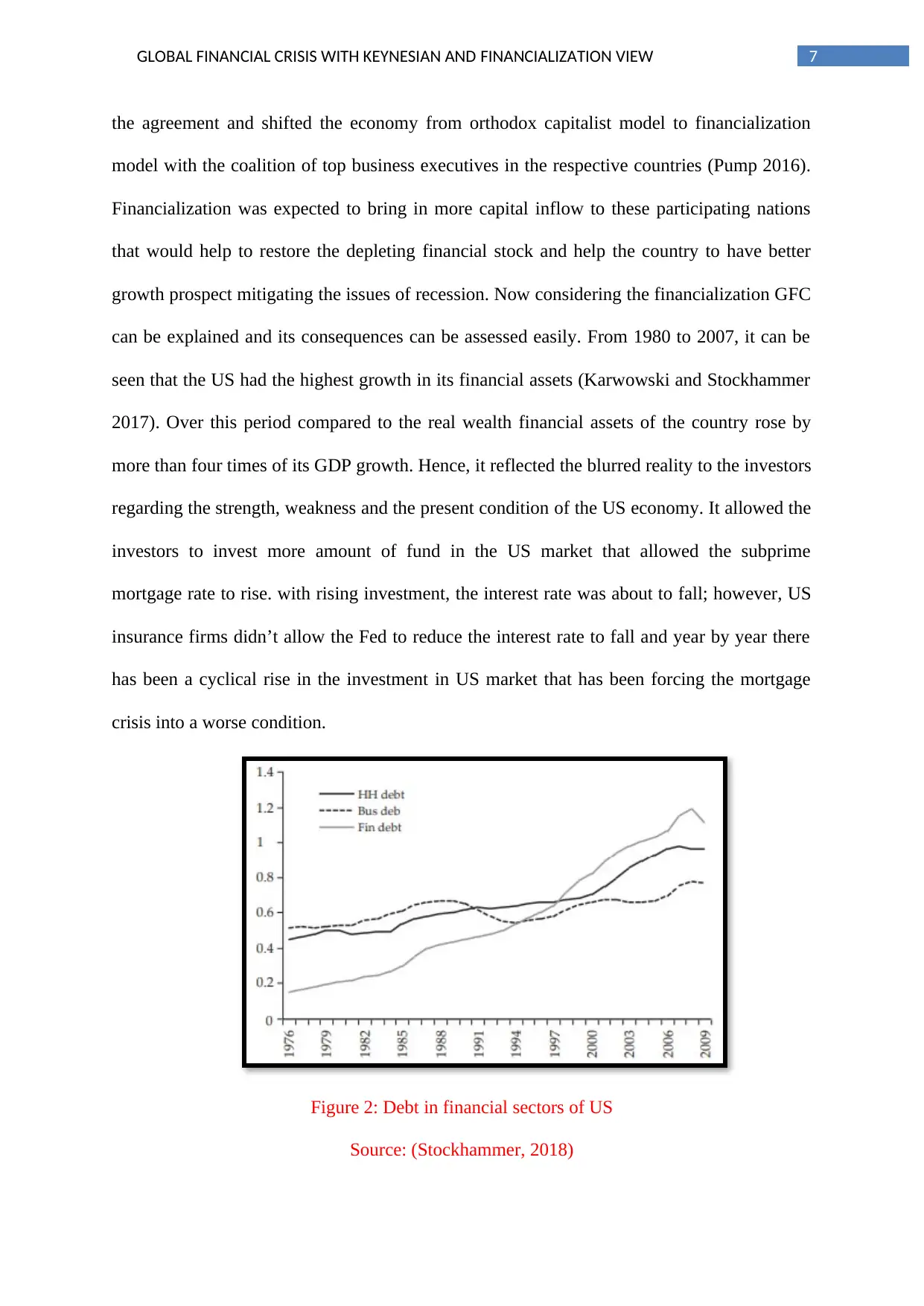
7GLOBAL FINANCIAL CRISIS WITH KEYNESIAN AND FINANCIALIZATION VIEW
the agreement and shifted the economy from orthodox capitalist model to financialization
model with the coalition of top business executives in the respective countries (Pump 2016).
Financialization was expected to bring in more capital inflow to these participating nations
that would help to restore the depleting financial stock and help the country to have better
growth prospect mitigating the issues of recession. Now considering the financialization GFC
can be explained and its consequences can be assessed easily. From 1980 to 2007, it can be
seen that the US had the highest growth in its financial assets (Karwowski and Stockhammer
2017). Over this period compared to the real wealth financial assets of the country rose by
more than four times of its GDP growth. Hence, it reflected the blurred reality to the investors
regarding the strength, weakness and the present condition of the US economy. It allowed the
investors to invest more amount of fund in the US market that allowed the subprime
mortgage rate to rise. with rising investment, the interest rate was about to fall; however, US
insurance firms didn’t allow the Fed to reduce the interest rate to fall and year by year there
has been a cyclical rise in the investment in US market that has been forcing the mortgage
crisis into a worse condition.
Figure 2: Debt in financial sectors of US
Source: (Stockhammer, 2018)
the agreement and shifted the economy from orthodox capitalist model to financialization
model with the coalition of top business executives in the respective countries (Pump 2016).
Financialization was expected to bring in more capital inflow to these participating nations
that would help to restore the depleting financial stock and help the country to have better
growth prospect mitigating the issues of recession. Now considering the financialization GFC
can be explained and its consequences can be assessed easily. From 1980 to 2007, it can be
seen that the US had the highest growth in its financial assets (Karwowski and Stockhammer
2017). Over this period compared to the real wealth financial assets of the country rose by
more than four times of its GDP growth. Hence, it reflected the blurred reality to the investors
regarding the strength, weakness and the present condition of the US economy. It allowed the
investors to invest more amount of fund in the US market that allowed the subprime
mortgage rate to rise. with rising investment, the interest rate was about to fall; however, US
insurance firms didn’t allow the Fed to reduce the interest rate to fall and year by year there
has been a cyclical rise in the investment in US market that has been forcing the mortgage
crisis into a worse condition.
Figure 2: Debt in financial sectors of US
Source: (Stockhammer, 2018)
Paraphrase This Document
Need a fresh take? Get an instant paraphrase of this document with our AI Paraphraser
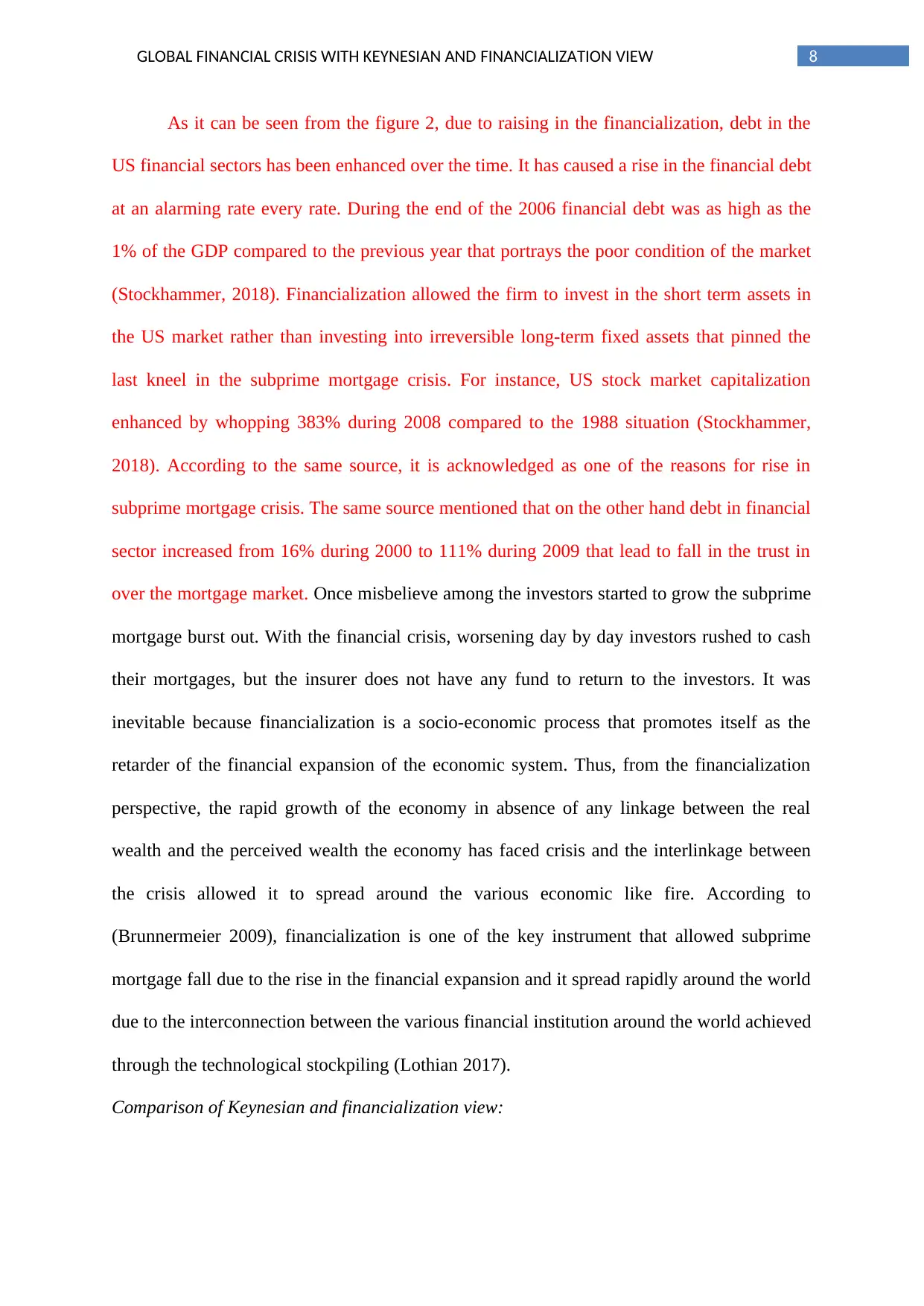
8GLOBAL FINANCIAL CRISIS WITH KEYNESIAN AND FINANCIALIZATION VIEW
As it can be seen from the figure 2, due to raising in the financialization, debt in the
US financial sectors has been enhanced over the time. It has caused a rise in the financial debt
at an alarming rate every rate. During the end of the 2006 financial debt was as high as the
1% of the GDP compared to the previous year that portrays the poor condition of the market
(Stockhammer, 2018). Financialization allowed the firm to invest in the short term assets in
the US market rather than investing into irreversible long-term fixed assets that pinned the
last kneel in the subprime mortgage crisis. For instance, US stock market capitalization
enhanced by whopping 383% during 2008 compared to the 1988 situation (Stockhammer,
2018). According to the same source, it is acknowledged as one of the reasons for rise in
subprime mortgage crisis. The same source mentioned that on the other hand debt in financial
sector increased from 16% during 2000 to 111% during 2009 that lead to fall in the trust in
over the mortgage market. Once misbelieve among the investors started to grow the subprime
mortgage burst out. With the financial crisis, worsening day by day investors rushed to cash
their mortgages, but the insurer does not have any fund to return to the investors. It was
inevitable because financialization is a socio-economic process that promotes itself as the
retarder of the financial expansion of the economic system. Thus, from the financialization
perspective, the rapid growth of the economy in absence of any linkage between the real
wealth and the perceived wealth the economy has faced crisis and the interlinkage between
the crisis allowed it to spread around the various economic like fire. According to
(Brunnermeier 2009), financialization is one of the key instrument that allowed subprime
mortgage fall due to the rise in the financial expansion and it spread rapidly around the world
due to the interconnection between the various financial institution around the world achieved
through the technological stockpiling (Lothian 2017).
Comparison of Keynesian and financialization view:
As it can be seen from the figure 2, due to raising in the financialization, debt in the
US financial sectors has been enhanced over the time. It has caused a rise in the financial debt
at an alarming rate every rate. During the end of the 2006 financial debt was as high as the
1% of the GDP compared to the previous year that portrays the poor condition of the market
(Stockhammer, 2018). Financialization allowed the firm to invest in the short term assets in
the US market rather than investing into irreversible long-term fixed assets that pinned the
last kneel in the subprime mortgage crisis. For instance, US stock market capitalization
enhanced by whopping 383% during 2008 compared to the 1988 situation (Stockhammer,
2018). According to the same source, it is acknowledged as one of the reasons for rise in
subprime mortgage crisis. The same source mentioned that on the other hand debt in financial
sector increased from 16% during 2000 to 111% during 2009 that lead to fall in the trust in
over the mortgage market. Once misbelieve among the investors started to grow the subprime
mortgage burst out. With the financial crisis, worsening day by day investors rushed to cash
their mortgages, but the insurer does not have any fund to return to the investors. It was
inevitable because financialization is a socio-economic process that promotes itself as the
retarder of the financial expansion of the economic system. Thus, from the financialization
perspective, the rapid growth of the economy in absence of any linkage between the real
wealth and the perceived wealth the economy has faced crisis and the interlinkage between
the crisis allowed it to spread around the various economic like fire. According to
(Brunnermeier 2009), financialization is one of the key instrument that allowed subprime
mortgage fall due to the rise in the financial expansion and it spread rapidly around the world
due to the interconnection between the various financial institution around the world achieved
through the technological stockpiling (Lothian 2017).
Comparison of Keynesian and financialization view:
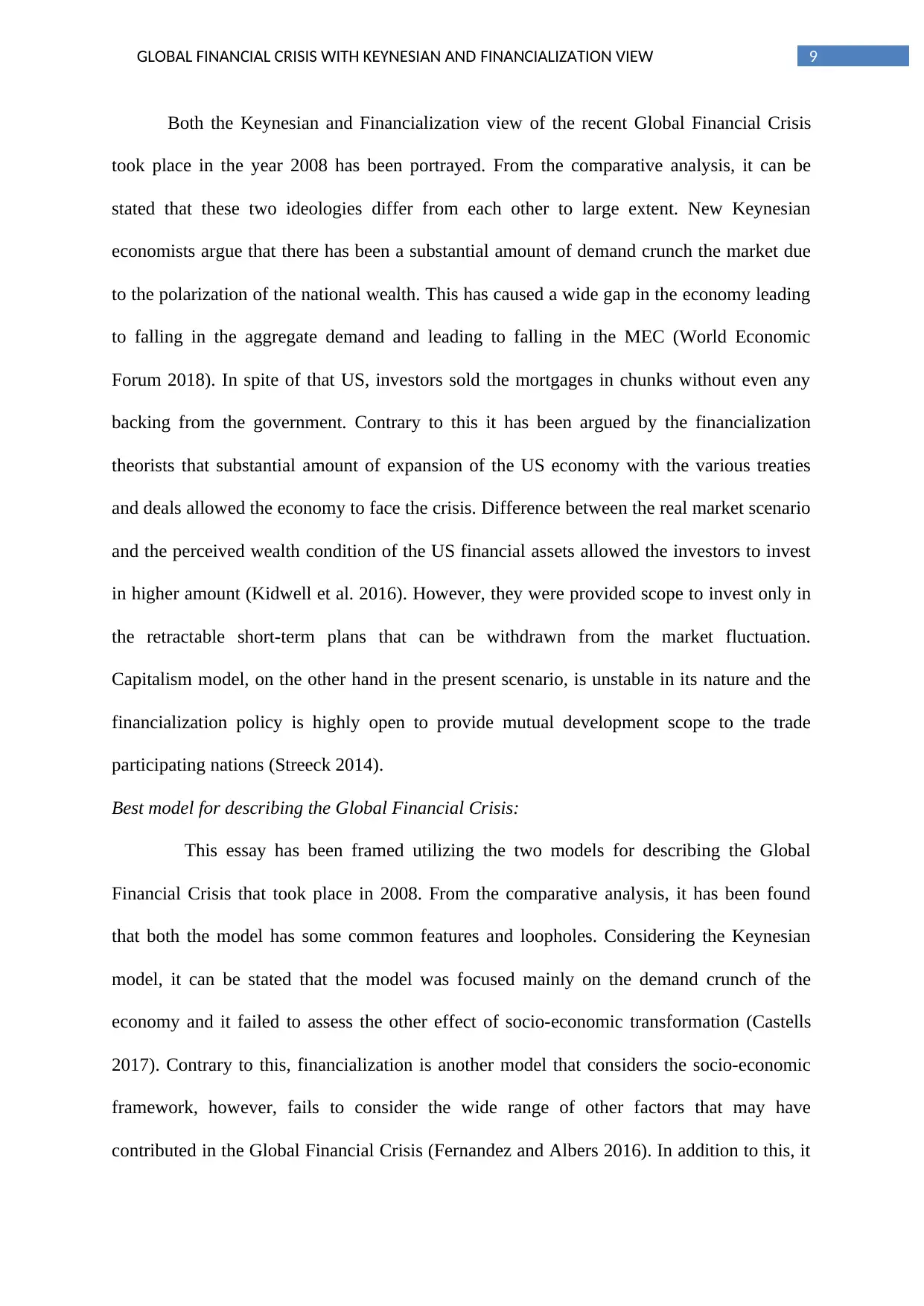
9GLOBAL FINANCIAL CRISIS WITH KEYNESIAN AND FINANCIALIZATION VIEW
Both the Keynesian and Financialization view of the recent Global Financial Crisis
took place in the year 2008 has been portrayed. From the comparative analysis, it can be
stated that these two ideologies differ from each other to large extent. New Keynesian
economists argue that there has been a substantial amount of demand crunch the market due
to the polarization of the national wealth. This has caused a wide gap in the economy leading
to falling in the aggregate demand and leading to falling in the MEC (World Economic
Forum 2018). In spite of that US, investors sold the mortgages in chunks without even any
backing from the government. Contrary to this it has been argued by the financialization
theorists that substantial amount of expansion of the US economy with the various treaties
and deals allowed the economy to face the crisis. Difference between the real market scenario
and the perceived wealth condition of the US financial assets allowed the investors to invest
in higher amount (Kidwell et al. 2016). However, they were provided scope to invest only in
the retractable short-term plans that can be withdrawn from the market fluctuation.
Capitalism model, on the other hand in the present scenario, is unstable in its nature and the
financialization policy is highly open to provide mutual development scope to the trade
participating nations (Streeck 2014).
Best model for describing the Global Financial Crisis:
This essay has been framed utilizing the two models for describing the Global
Financial Crisis that took place in 2008. From the comparative analysis, it has been found
that both the model has some common features and loopholes. Considering the Keynesian
model, it can be stated that the model was focused mainly on the demand crunch of the
economy and it failed to assess the other effect of socio-economic transformation (Castells
2017). Contrary to this, financialization is another model that considers the socio-economic
framework, however, fails to consider the wide range of other factors that may have
contributed in the Global Financial Crisis (Fernandez and Albers 2016). In addition to this, it
Both the Keynesian and Financialization view of the recent Global Financial Crisis
took place in the year 2008 has been portrayed. From the comparative analysis, it can be
stated that these two ideologies differ from each other to large extent. New Keynesian
economists argue that there has been a substantial amount of demand crunch the market due
to the polarization of the national wealth. This has caused a wide gap in the economy leading
to falling in the aggregate demand and leading to falling in the MEC (World Economic
Forum 2018). In spite of that US, investors sold the mortgages in chunks without even any
backing from the government. Contrary to this it has been argued by the financialization
theorists that substantial amount of expansion of the US economy with the various treaties
and deals allowed the economy to face the crisis. Difference between the real market scenario
and the perceived wealth condition of the US financial assets allowed the investors to invest
in higher amount (Kidwell et al. 2016). However, they were provided scope to invest only in
the retractable short-term plans that can be withdrawn from the market fluctuation.
Capitalism model, on the other hand in the present scenario, is unstable in its nature and the
financialization policy is highly open to provide mutual development scope to the trade
participating nations (Streeck 2014).
Best model for describing the Global Financial Crisis:
This essay has been framed utilizing the two models for describing the Global
Financial Crisis that took place in 2008. From the comparative analysis, it has been found
that both the model has some common features and loopholes. Considering the Keynesian
model, it can be stated that the model was focused mainly on the demand crunch of the
economy and it failed to assess the other effect of socio-economic transformation (Castells
2017). Contrary to this, financialization is another model that considers the socio-economic
framework, however, fails to consider the wide range of other factors that may have
contributed in the Global Financial Crisis (Fernandez and Albers 2016). In addition to this, it
⊘ This is a preview!⊘
Do you want full access?
Subscribe today to unlock all pages.

Trusted by 1+ million students worldwide
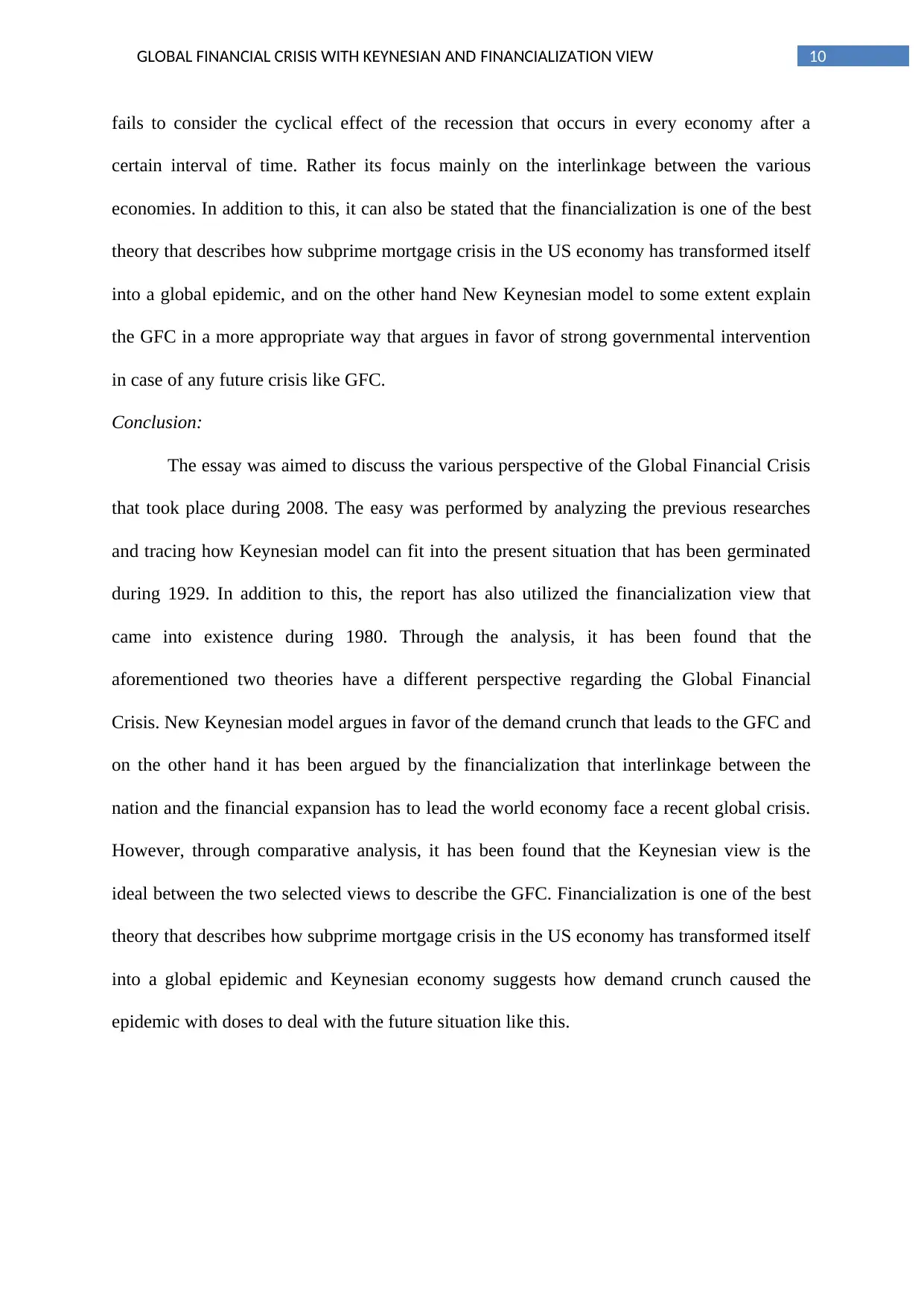
10GLOBAL FINANCIAL CRISIS WITH KEYNESIAN AND FINANCIALIZATION VIEW
fails to consider the cyclical effect of the recession that occurs in every economy after a
certain interval of time. Rather its focus mainly on the interlinkage between the various
economies. In addition to this, it can also be stated that the financialization is one of the best
theory that describes how subprime mortgage crisis in the US economy has transformed itself
into a global epidemic, and on the other hand New Keynesian model to some extent explain
the GFC in a more appropriate way that argues in favor of strong governmental intervention
in case of any future crisis like GFC.
Conclusion:
The essay was aimed to discuss the various perspective of the Global Financial Crisis
that took place during 2008. The easy was performed by analyzing the previous researches
and tracing how Keynesian model can fit into the present situation that has been germinated
during 1929. In addition to this, the report has also utilized the financialization view that
came into existence during 1980. Through the analysis, it has been found that the
aforementioned two theories have a different perspective regarding the Global Financial
Crisis. New Keynesian model argues in favor of the demand crunch that leads to the GFC and
on the other hand it has been argued by the financialization that interlinkage between the
nation and the financial expansion has to lead the world economy face a recent global crisis.
However, through comparative analysis, it has been found that the Keynesian view is the
ideal between the two selected views to describe the GFC. Financialization is one of the best
theory that describes how subprime mortgage crisis in the US economy has transformed itself
into a global epidemic and Keynesian economy suggests how demand crunch caused the
epidemic with doses to deal with the future situation like this.
fails to consider the cyclical effect of the recession that occurs in every economy after a
certain interval of time. Rather its focus mainly on the interlinkage between the various
economies. In addition to this, it can also be stated that the financialization is one of the best
theory that describes how subprime mortgage crisis in the US economy has transformed itself
into a global epidemic, and on the other hand New Keynesian model to some extent explain
the GFC in a more appropriate way that argues in favor of strong governmental intervention
in case of any future crisis like GFC.
Conclusion:
The essay was aimed to discuss the various perspective of the Global Financial Crisis
that took place during 2008. The easy was performed by analyzing the previous researches
and tracing how Keynesian model can fit into the present situation that has been germinated
during 1929. In addition to this, the report has also utilized the financialization view that
came into existence during 1980. Through the analysis, it has been found that the
aforementioned two theories have a different perspective regarding the Global Financial
Crisis. New Keynesian model argues in favor of the demand crunch that leads to the GFC and
on the other hand it has been argued by the financialization that interlinkage between the
nation and the financial expansion has to lead the world economy face a recent global crisis.
However, through comparative analysis, it has been found that the Keynesian view is the
ideal between the two selected views to describe the GFC. Financialization is one of the best
theory that describes how subprime mortgage crisis in the US economy has transformed itself
into a global epidemic and Keynesian economy suggests how demand crunch caused the
epidemic with doses to deal with the future situation like this.
Paraphrase This Document
Need a fresh take? Get an instant paraphrase of this document with our AI Paraphraser
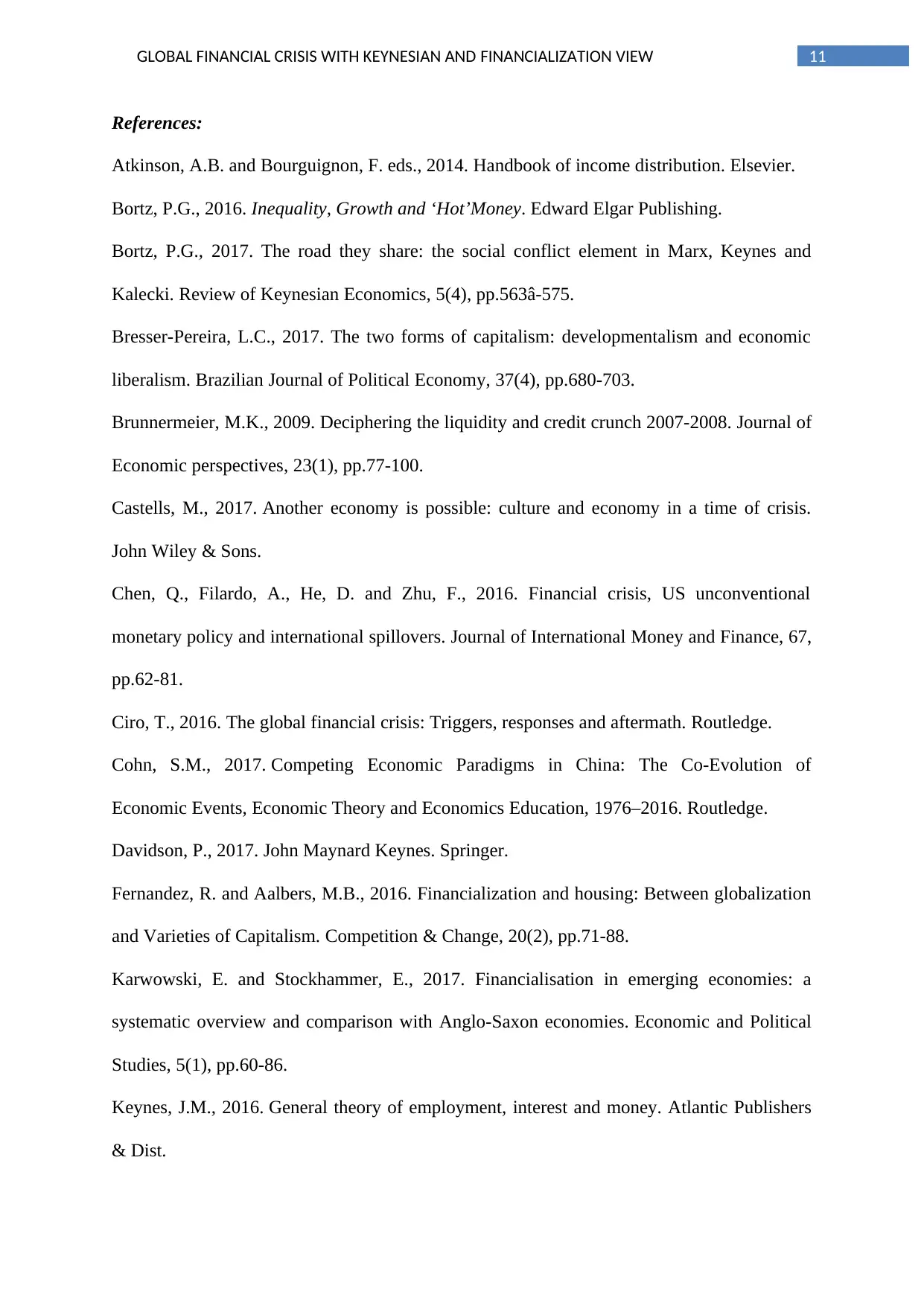
11GLOBAL FINANCIAL CRISIS WITH KEYNESIAN AND FINANCIALIZATION VIEW
References:
Atkinson, A.B. and Bourguignon, F. eds., 2014. Handbook of income distribution. Elsevier.
Bortz, P.G., 2016. Inequality, Growth and ‘Hot’Money. Edward Elgar Publishing.
Bortz, P.G., 2017. The road they share: the social conflict element in Marx, Keynes and
Kalecki. Review of Keynesian Economics, 5(4), pp.563â-575.
Bresser-Pereira, L.C., 2017. The two forms of capitalism: developmentalism and economic
liberalism. Brazilian Journal of Political Economy, 37(4), pp.680-703.
Brunnermeier, M.K., 2009. Deciphering the liquidity and credit crunch 2007-2008. Journal of
Economic perspectives, 23(1), pp.77-100.
Castells, M., 2017. Another economy is possible: culture and economy in a time of crisis.
John Wiley & Sons.
Chen, Q., Filardo, A., He, D. and Zhu, F., 2016. Financial crisis, US unconventional
monetary policy and international spillovers. Journal of International Money and Finance, 67,
pp.62-81.
Ciro, T., 2016. The global financial crisis: Triggers, responses and aftermath. Routledge.
Cohn, S.M., 2017. Competing Economic Paradigms in China: The Co-Evolution of
Economic Events, Economic Theory and Economics Education, 1976–2016. Routledge.
Davidson, P., 2017. John Maynard Keynes. Springer.
Fernandez, R. and Aalbers, M.B., 2016. Financialization and housing: Between globalization
and Varieties of Capitalism. Competition & Change, 20(2), pp.71-88.
Karwowski, E. and Stockhammer, E., 2017. Financialisation in emerging economies: a
systematic overview and comparison with Anglo-Saxon economies. Economic and Political
Studies, 5(1), pp.60-86.
Keynes, J.M., 2016. General theory of employment, interest and money. Atlantic Publishers
& Dist.
References:
Atkinson, A.B. and Bourguignon, F. eds., 2014. Handbook of income distribution. Elsevier.
Bortz, P.G., 2016. Inequality, Growth and ‘Hot’Money. Edward Elgar Publishing.
Bortz, P.G., 2017. The road they share: the social conflict element in Marx, Keynes and
Kalecki. Review of Keynesian Economics, 5(4), pp.563â-575.
Bresser-Pereira, L.C., 2017. The two forms of capitalism: developmentalism and economic
liberalism. Brazilian Journal of Political Economy, 37(4), pp.680-703.
Brunnermeier, M.K., 2009. Deciphering the liquidity and credit crunch 2007-2008. Journal of
Economic perspectives, 23(1), pp.77-100.
Castells, M., 2017. Another economy is possible: culture and economy in a time of crisis.
John Wiley & Sons.
Chen, Q., Filardo, A., He, D. and Zhu, F., 2016. Financial crisis, US unconventional
monetary policy and international spillovers. Journal of International Money and Finance, 67,
pp.62-81.
Ciro, T., 2016. The global financial crisis: Triggers, responses and aftermath. Routledge.
Cohn, S.M., 2017. Competing Economic Paradigms in China: The Co-Evolution of
Economic Events, Economic Theory and Economics Education, 1976–2016. Routledge.
Davidson, P., 2017. John Maynard Keynes. Springer.
Fernandez, R. and Aalbers, M.B., 2016. Financialization and housing: Between globalization
and Varieties of Capitalism. Competition & Change, 20(2), pp.71-88.
Karwowski, E. and Stockhammer, E., 2017. Financialisation in emerging economies: a
systematic overview and comparison with Anglo-Saxon economies. Economic and Political
Studies, 5(1), pp.60-86.
Keynes, J.M., 2016. General theory of employment, interest and money. Atlantic Publishers
& Dist.
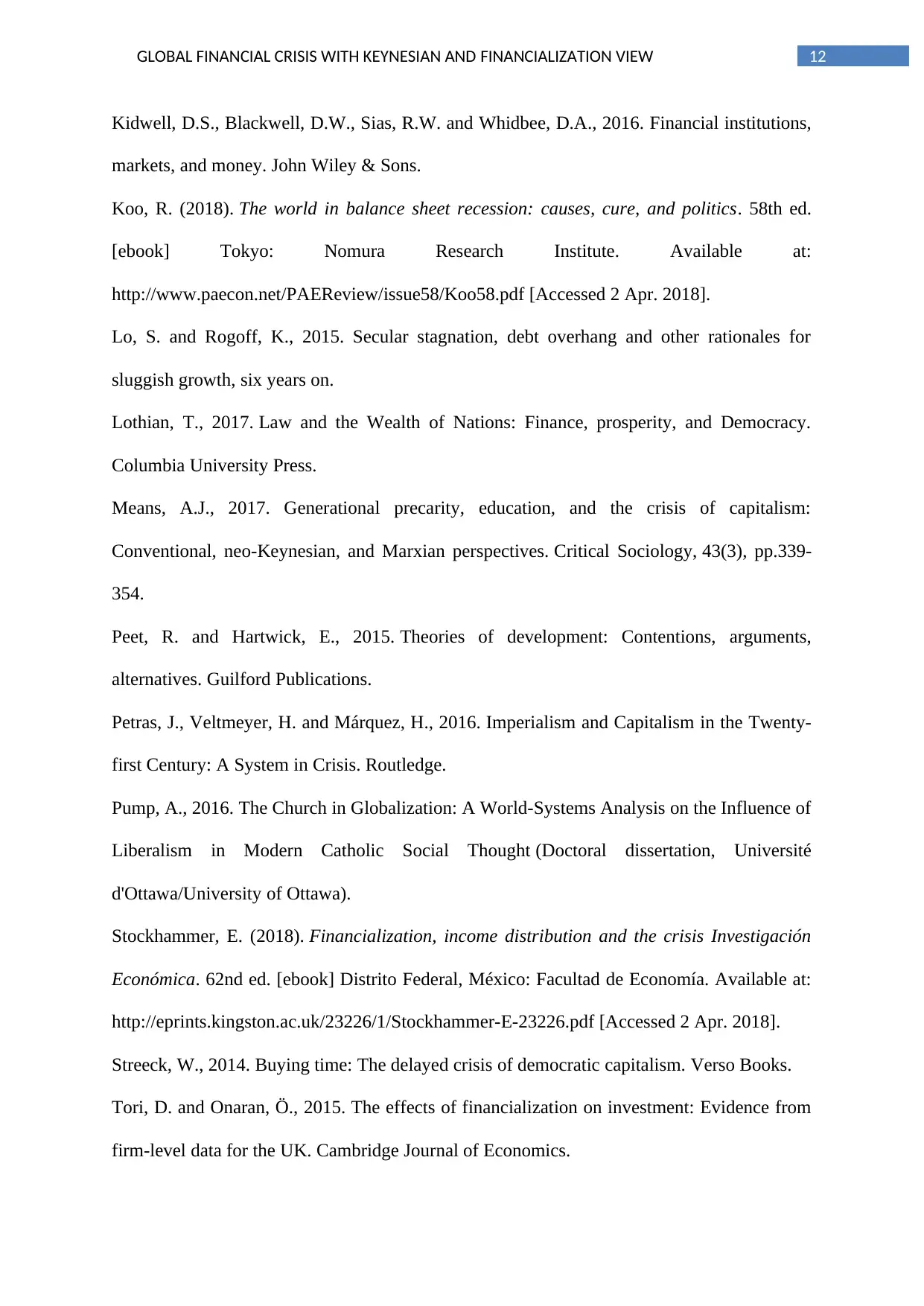
12GLOBAL FINANCIAL CRISIS WITH KEYNESIAN AND FINANCIALIZATION VIEW
Kidwell, D.S., Blackwell, D.W., Sias, R.W. and Whidbee, D.A., 2016. Financial institutions,
markets, and money. John Wiley & Sons.
Koo, R. (2018). The world in balance sheet recession: causes, cure, and politics. 58th ed.
[ebook] Tokyo: Nomura Research Institute. Available at:
http://www.paecon.net/PAEReview/issue58/Koo58.pdf [Accessed 2 Apr. 2018].
Lo, S. and Rogoff, K., 2015. Secular stagnation, debt overhang and other rationales for
sluggish growth, six years on.
Lothian, T., 2017. Law and the Wealth of Nations: Finance, prosperity, and Democracy.
Columbia University Press.
Means, A.J., 2017. Generational precarity, education, and the crisis of capitalism:
Conventional, neo-Keynesian, and Marxian perspectives. Critical Sociology, 43(3), pp.339-
354.
Peet, R. and Hartwick, E., 2015. Theories of development: Contentions, arguments,
alternatives. Guilford Publications.
Petras, J., Veltmeyer, H. and Márquez, H., 2016. Imperialism and Capitalism in the Twenty-
first Century: A System in Crisis. Routledge.
Pump, A., 2016. The Church in Globalization: A World-Systems Analysis on the Influence of
Liberalism in Modern Catholic Social Thought (Doctoral dissertation, Université
d'Ottawa/University of Ottawa).
Stockhammer, E. (2018). Financialization, income distribution and the crisis Investigación
Económica. 62nd ed. [ebook] Distrito Federal, México: Facultad de Economía. Available at:
http://eprints.kingston.ac.uk/23226/1/Stockhammer-E-23226.pdf [Accessed 2 Apr. 2018].
Streeck, W., 2014. Buying time: The delayed crisis of democratic capitalism. Verso Books.
Tori, D. and Onaran, Ö., 2015. The effects of financialization on investment: Evidence from
firm-level data for the UK. Cambridge Journal of Economics.
Kidwell, D.S., Blackwell, D.W., Sias, R.W. and Whidbee, D.A., 2016. Financial institutions,
markets, and money. John Wiley & Sons.
Koo, R. (2018). The world in balance sheet recession: causes, cure, and politics. 58th ed.
[ebook] Tokyo: Nomura Research Institute. Available at:
http://www.paecon.net/PAEReview/issue58/Koo58.pdf [Accessed 2 Apr. 2018].
Lo, S. and Rogoff, K., 2015. Secular stagnation, debt overhang and other rationales for
sluggish growth, six years on.
Lothian, T., 2017. Law and the Wealth of Nations: Finance, prosperity, and Democracy.
Columbia University Press.
Means, A.J., 2017. Generational precarity, education, and the crisis of capitalism:
Conventional, neo-Keynesian, and Marxian perspectives. Critical Sociology, 43(3), pp.339-
354.
Peet, R. and Hartwick, E., 2015. Theories of development: Contentions, arguments,
alternatives. Guilford Publications.
Petras, J., Veltmeyer, H. and Márquez, H., 2016. Imperialism and Capitalism in the Twenty-
first Century: A System in Crisis. Routledge.
Pump, A., 2016. The Church in Globalization: A World-Systems Analysis on the Influence of
Liberalism in Modern Catholic Social Thought (Doctoral dissertation, Université
d'Ottawa/University of Ottawa).
Stockhammer, E. (2018). Financialization, income distribution and the crisis Investigación
Económica. 62nd ed. [ebook] Distrito Federal, México: Facultad de Economía. Available at:
http://eprints.kingston.ac.uk/23226/1/Stockhammer-E-23226.pdf [Accessed 2 Apr. 2018].
Streeck, W., 2014. Buying time: The delayed crisis of democratic capitalism. Verso Books.
Tori, D. and Onaran, Ö., 2015. The effects of financialization on investment: Evidence from
firm-level data for the UK. Cambridge Journal of Economics.
⊘ This is a preview!⊘
Do you want full access?
Subscribe today to unlock all pages.

Trusted by 1+ million students worldwide
1 out of 13
Related Documents
Your All-in-One AI-Powered Toolkit for Academic Success.
+13062052269
info@desklib.com
Available 24*7 on WhatsApp / Email
![[object Object]](/_next/static/media/star-bottom.7253800d.svg)
Unlock your academic potential
Copyright © 2020–2025 A2Z Services. All Rights Reserved. Developed and managed by ZUCOL.





